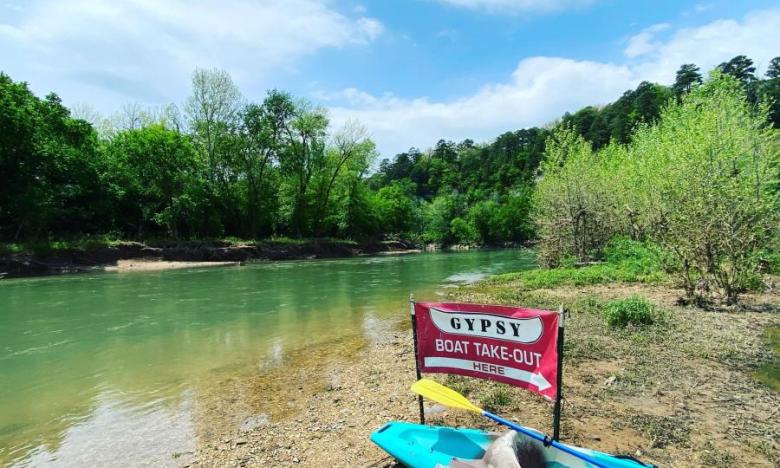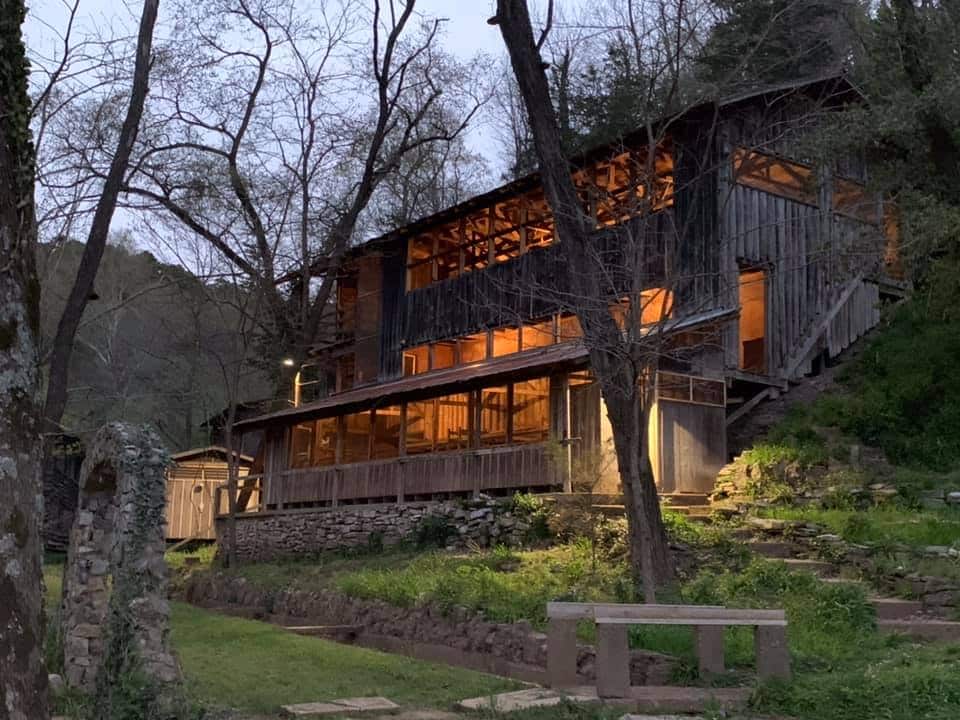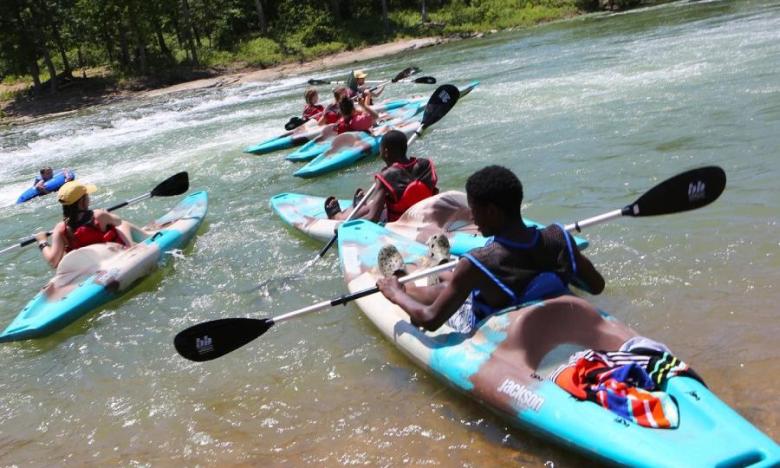Nestled in the mouth of a narrow ravine near a 90-degree bend in the Illinois River under large overhanging bluffs sits Gypsy Camp & Canoe. The dramatic landscape has a history that channels the gypsies of Europe as well as a connection to the great outdoors.
Located near Siloam Springs in Northwest Arkansas at a former and historic summer camp for girls, Gypsy Camp & Canoe is the only outfitter on the Illinois River. “Very few people know about the Illinois River as a recreational opportunity,” explained Gypsy Manager Jerrid Gelinas.
“We rent kayaks, rafts, canoes and do personal shuttles,” said Gelinas, who owns the business with partners. “We have a good float for all levels.”
Currently, Gypsy Camp & Canoe offers a four-mile float and a 12-mile float starting upstream with take-out at Gypsy. Both pass through the Siloam Springs Kayak Parkwith two Class II rapids and have places to stop and swim. He said the 12-mile float is an easy but long paddle and a full day on the river.
“We get to offer a great pace. We have the fun of a short float and long float,” he said. The experience is very family-friendly and the river is not as busy as some of the other float streams in the state, except maybe on major holidays.
Next year, Gypsy will add a four-mile float downstream to WOKA Whitewater Park. Currently, under construction in Oklahoma near the Arkansas border, WOKA will be a best-in-class whitewater park featuring a 1,200-foot long, 100-foot wide side channel off of the Illinois River with eight drop features.
The Illinois River can be floated year-round. “We’ve probably got the best floatable river in the state,” Gelinas said. “We never have to worry about too little water.”
In addition to floating, Gypsy Camp & Canoe offers hiking too. About a mile of trail up behind the cabins goes under a quarter-mile-long bluff overhang. “It’s probably one of the central points of camp,” Gelinas added. The hillsides above the camp are dotted with large, overhanging limestone bluffs.


Gypsy Camp has 22 primitive tent sites, 7 electric sites with 30 AMP electric hookups, and 10 hammock sites. Most campsites are located on or near the river banks. Large group camping sites are available too.
While not available for rent yet, the property does contain cabins and other facilities originally built for the Gypsy Camp for Girls. This private, thematic summer camp operated from 1922 to 1978. According to documentation filed with the Library of Congress, “The camp was the brainchild of Weesie Griffith McAllister, the director of the art department at the University of Tulsa in Tulsa, Oklahoma. Her inspiration for the camp came from gypsy camps she had observed while traveling in Europe.
“The camp’s dramatic landscape setting…reinforced the theatricality and romantic imagery conjured by the camp’s theme. The Gypsy Camp was one of four prominent girls’ camps established in Arkansas in the 1910s and 20s, serving girls from Arkansas and surrounding states. These camps were products of a national movement promoting health and education benefits of summer camps for girls (summer camps for boys became popular in the late nineteenth century). All four camps operated successfully until the 1960s and 70s, when they closed due to widespread cultural shifts which led to declining enrollment numbers. Unlike the other three former camps, the Gypsy Camp retains much of its original character…. The Gypsy Camp is the last largely intact representation of the formative period of an important American landscape genre, the girls’ summer camp, in the state of Arkansas.”
The camp was listed on the National Register of Historic Places in 1988. It was owned by the family of the gypsy camp founders for 99 years until sold to Gelinas and his partners in 2018.
“To come to gypsy camp meant you had to have the right opportunities at the time to be able to travel from say Dallas to Siloam [Springs],” Gelinas explained. In the early 1900s, the girls would come by train to the depot in Siloam Springs, where camp staff would pick them up and transport them to the camp. “It was very desolate out here,” Gelinas added. Even when the gypsy camp ended in 1978, Northwest Arkansas was still a very rural area dotted with small towns.
“We do have a pretty good connection with the original gypsies. They do a reunion here every year,” Gelinas said. “That’s kind of neat to see it through their eyes. There are probably 20 of them or so. It’s really cool to see the impact this camp has had on these women.”
“One of the things we’re kind of bringing back is some of the activities they did,” Gelinas added. He is reinstalling the original camp basketball goal and setting up volleyball and tennnis courts this year.
Gypsy also plans to bring back stays in the historic cabins, which owners started renovating after purchasing the camp in 2018. The property has 13,000 square feet of building space. Gelinas said, “the buildings have been well maintained just because of how they were built with lumber milled here on site.”

According to the Library of Congress, “The architectural materials used to construct the Gypsy Camp’s buildings and site features are an integral part of the camp’s distinct rustic character. The vernacular architectural materials used at the Gypsy camp changed throughout the sixty years the camp was in operation as lumber became more readily available. This is very important to the character of the camp today.
“The early camp buildings dating from the 1920s were constructed from a mixture of local materials including native field limestone, concrete, pine logs, pine clapboard siding, and wood framing. Most of the wood products were harvested and milled on site. More recent additions and repairs to the camp (1960s-2011) have consisted of manufactured lumber products such as plywood and prefabricated pine siding that were purchased in Siloam Springs, the nearest town to the north…
“A combination of both old and newer materials has become the vernacular of rural areas in the Ozark Mountains, and therefore this combination of materials has had a very negligible impact on the integrity and overall appearance of the Gypsy Camp. These somewhat eclectic architectural materials, together with the dramatic topography, have created the character that defines the Gypsy Camp today.”
The original intent of the Gypsy Camp certainly lives on through the property’s new use by Gypsy Camp & Canoe. It may not be solely for girls any longer, but the recreational benefits of camp life and connection to nature for those that visit continue.



